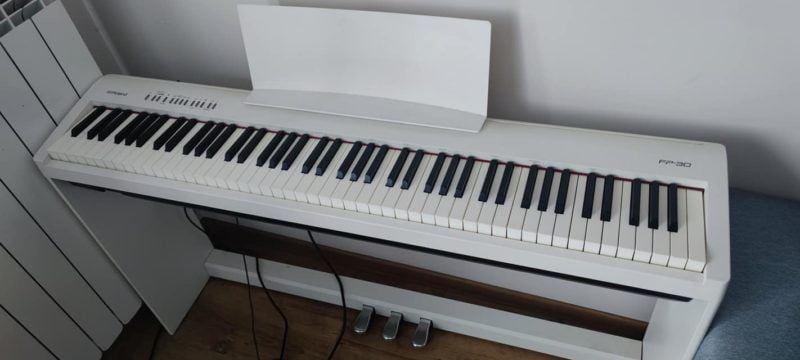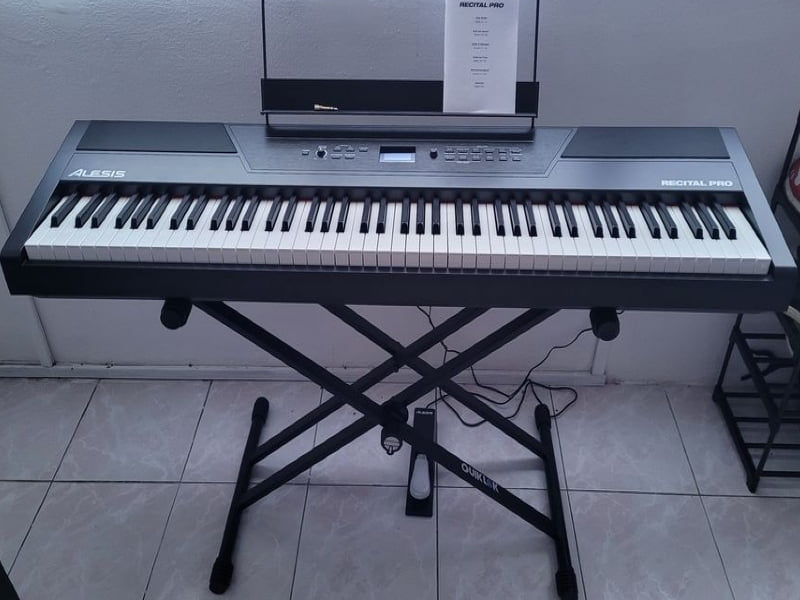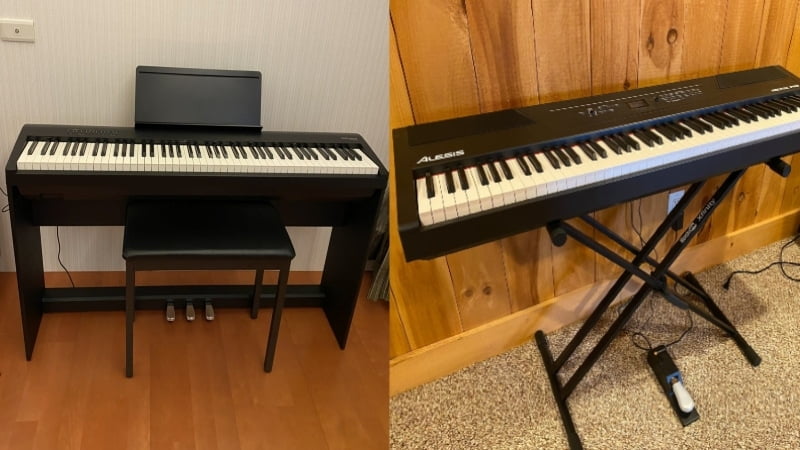Looking for a good digital piano on a budget? Find the best option for you in this Alesis Recital Pro vs Roland FP-30 comparison.
Most people don’t have the space or the budget to put a real acoustic piano in their homes. But nowadays, you can find many digital pianos that sound great and work just as well as an acoustic piano on a budget.
And if you’re on the hunt for an affordable digital piano that can compete with ones in higher price ranges, you might be comparing the Alesis Recital Pro vs the Roland FP-30. These are two top-tier digital pianos available on a budget, and today, I’ll be showing you which one is the better option.
After testing both pianos and comparing their sounds, piano features, and feel, I found the Roland FP-30 to have a slight edge. That’s why I would happily recommend this piano over the Alesis Recital Pro to anyone.
That said, there were a few features on the Alesis Recital Pro definitely worth noting. So, keep reading as I’ll dive into more details in the rest of this article.
Alesis Recital Pro vs Roland FP-30: A Head-to-Head Comparison




Last update on 2025-07-04 / Affiliate links / Images from Amazon Product Advertising API
Alesis Recital Pro vs Roland FP-30: A Head-to-Head Comparison
The Alesis Recital Pro and the Roland FP-30 may look similar on the surface, but they are two very distinct instruments. And when I tested out all their features and compared them against each other, the Roland FP-30 won with a final score of 3-1.
But even if the Roland FP-30 won this comparison by two points, the Alesis Recital Pro put up a really good fight. Below, I’ll explain each piano’s different features to show you why the Roland FP-30 is the better pick.
Feel & Playability
The winner: Roland FP-30
The first feature I look at when testing a digital piano is the feel. You always want to find a piano that replicates the feel of an acoustic piano, and I found that the Roland FP-30 does a better job at that compared to the Alesis Recital Pro.
+Hammer Action
The Alesis Recital Pro features fully weighted keys. This is great for any pianist as it adds a lot more realism when playing the piano compared to non-weighted keys. That said, I noticed the weight on the Alesis’ keys felt very uniform. Acoustic pianos usually have subtle weight differences between the keys, so the Alesis Recital Pro didn’t feel as realistic as I would have expected.
On the other hand, the Roland FP-30 features PHA-4 hammer action. This is Roland’s own hammer action system you can find on many of their pianos that aims to replicate the real weight of an acoustic piano. So, you can expect the bass keys to be a bit heavier compared to the treble keys, which makes the piano feel great.
On top of that, the Roland FP-30 features textured plastic keys. The Recital Pro has glossy plastic keys, and they feel very slippery when playing. It won’t get in the way of the way you play the piano, but it’s definitely noticeable. With the FP-30, you don’t get this slippery feeling. In fact, Roland’s keys are pretty similar to real wooden keys on an acoustic piano, which was a neat surprise.
Tone
The winner: Roland FP-30
The next comparison point was the tone, or how the pianos sounded. And again, I found that the Roland FP-30 came out on top. With its top-tier tone generator and varied sound library, it was hard for the Alesis Recital Pro to put up a fight
+Tone Generation

I didn’t expect much from either of these pianos when it came to tone. Since these are some of the more affordable options from either brand, I thought they would come with sub-par piano tones. But luckily, I got the chance to test them out and found out that my assumptions were wrong.
To my surprise, both of the pianos produced fairly realistic tones for their price range. The Alesis Recital Pro does this through standard sampling techniques. And while this is a simple approach, I have to say they did it well.
The Roland FP-30, however, has a slightly better tone generation system. The Roland has the SuperNatural Piano sound that offers a much more vibrant and realistic set of piano tones. And while the difference wasn’t too big, I have to say that if you’re particular about sound quality, the Roland FP-30 is clearly the better pick.
+Sound Library
The Alesis Recital Pro comes with all the basic tones. It only comes with 10 voices, which is all you’ll need as a beginner. You can choose from various piano tones, electric pianos, strings, and even organ voices. This isn’t the most varied library, but it covers most of the instruments you’d want to play when starting out.
The Roland FP-30 has a much more versatile sound library. All in all, this piano has around 35 different voices. This offers a lot of variety and allows you to find tones that are suited to your playing style. If you’re a beginner, you might want to avoid large sound libraries like these, as they can get distracting.
However, if you like playing different styles of music and need versatility, then the Roland FP-30 is a clear choice.
Piano Features
The winner: Tie
One area where the Alesis Recital Pro put up a really close fight was in the piano features. Both pianos have the same polyphony and a decent set of effects. So, I couldn’t find a winner for this category and just gave the point to both pianos.

+Effects
The Roland FP-30 has Brilliance and Ambience effects. These are effects are designed for experienced pianists who want full control over their tone. These aren’t the most useful effects for beginners as they only make a subtle difference. But again, there are many pianists that need full control over their sound, and the FP-30 allows them to have that.
The Alesis Recital Pro has a more obvious set of effects. This piano comes with chorus, modulation, and reverb effects. This allows you to add much more depth and color to your tone, which is why it might be the better option for beginners.
+Polyphony
Both of these pianos have 128-note maximum polyphony. This means that the pianos can play up to 128 notes at the same time. So, if you plan on playing long passages with the sustain pedal and want the notes to ring out for a long time, both of these pianos can do it. Additionally, this gives the piano a lot of clarity even when blending and layering two voices on top of each other.
Alesis Recital Pro vs Roland FP-30: The Similarities
The biggest similarity between these two pianos is their design. These instruments are designed to be easy to carry around. That way, if you have piano lessons, a jam, gig, or even rehearsals, it won’t be hard to bring the piano with you. That’s one of the biggest advantages of portable digital pianos and why they’re a favorite for many musicians.
On top of that, these pianos share a similar speaker system. They are great for practicing alone or for piano lessons. However, keep in mind that these speakers aren’t that loud. So, if you want to make sure you’re heard when playing with other musicians or at a gig, you have to plug in to another sound system.
Quick Rundown of the Alesis Recital Pro
- A Digital Piano That’s Tailored to You - Feature-packed electric keyboard with 88 premium full-sized weighted hammer action keys with adjustable touch response to suit your preferred playing style
- Premium Sounds - 12 voices (Incl. Acoustic Piano, Electric Piano, Organ, Synth, and Bass), built-in FX: Chorus, Modulation, Reverb, and two built in 20W speakers for clear, room-filling sound
- All The Right Connections - ¼” sustain pedal input (pedal not included), ¼” stereo headphone output for private practice and stereo outputs for connection to speakers / amplifiers
- Play the Keyboard Wherever You Go - Power via the included power adapter or 6 D cell batteries (not included) for professional piano performance anywhere
- Powerful Educational Features - Standard, split, layer, record and lesson modes with 128-note max polyphony and Skoove 3 month premium subscription for expert interactive online piano lessons
Last update on 2025-07-04 / Affiliate links / Images from Amazon Product Advertising API
Quick Rundown of the Roland FP-30
- Rich, responsive tone from Roland renowned supernatural piano sound engine
- 88-Note Phat-4 standard keyboard provides authentic piano touch for maximum expression
- Powerful amplifier and stereo speakers deliver impressive sound
- Headphones output and quiet keyboard action allow you to enjoy playing at any time without disturbing others
- Optional matching stand and three-pedal unit provide a classic piano look and Enhanced functionality, including hands-free page turning with some sheet music apps
Last update on 2025-07-04 / Affiliate links / Images from Amazon Product Advertising API
Product Videos
References:
- Alesis Recital Pro: https://www.alesis.com/products/view/recital-pro
- Roland FP-30: https://www.roland.com/global/products/fp-30/specifications/
Lulacruza is an electronic folk duo operating at the junction of the hypermodern and the ancient. Our music weaves together hypnotic female singing, South American folk instruments and electronic processing, while channeling pulsating waves from the source of creation.
Lalucruza is also a community where you can connect with other music lovers to collaborate, exchange ideas and share knowledge. A platform for who wants to learns the basics of playing piano, guitar, drum masters’ technique, etc.. is the premise of our website.
